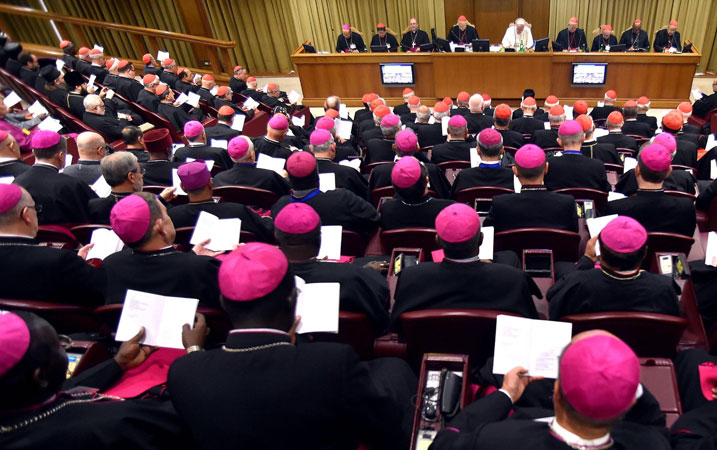Which Is the Real Narrative for the Riveting Theatre of the Synod?
By John L. Allen
A Synod of Bishops at the Vatican is always a sprawling, multi-headed creature, and that’s certainly been true of the 2015 edition devoted to issues facing the family. There have been hundreds of speeches, three sets of reports from 13 small working groups, daily press briefings, more media interviews than anyone can possibly track, not to mention a daily avalanche of commentary from a staggering variety of voices. On Saturday, the synod is expected to adopt a final document. It likely will be a long, complex text, and on some contested points, its language may be intentionally vague in order to attract consensus. Given all that, in some ways it’s misleading to talk about “the” Synod of Bishops, singular. In terms of perceptions, there are actually several different synods, plural, depending on who’s trying to describe it and what agenda they bring. As the end nears, three competing narratives seem to be floating around both inside and outside the synod hall. In shorthand fashion, they are: The “Everything’s Fine” narrative: This view holds that impressions of clash and rivalries have been exaggerated, that differences in the synod haven’t meant division, and that the bishops are united on a wide range of matters. The “Rigged Synod” narrative: This storyline holds that from the beginning, the people in charge of the synod have been pushing a progressive line, and that conservatives have had to fight back to try to level the playing field. The “Don’t Like the Pope” narrative: This way of framing the situation posits that concerns about the synod process are artificial, that the event is actually remarkably free and open, so such complaints are really a proxy for opposition to Pope Francis. Each of those narratives have influential spokesmen among the 270 bishops taking part in the synod, as well as a strong following among those tracking the event from the outside. On Oct. 12, Cardinal Oscar Rodriguez Maradiaga of Honduras, coordinator of the pope’s all-important council of cardinal advisors, articulated the “everything’s fine” view. “It seems to me that no one here wants to be in opposition or bring confrontations,” he said in an interview with Rome Reports. “Some in the media want to present it that way because that is the style of the world today.” “Here,” Rodriguez insisted, “we are all united under the light of the Holy Spirit and under the love of God.” (That view took a hit on Wednesday when Cardinal Reinhard Marx of Germany used a Vatican press briefing to identify Cardinal George Pell of Australia as the figure to whom the German working group was referring when it complained of comments which were “not only simplistic and wrong, but hurtful.”) In terms of the “rigging” narrative, none of the bishops themselves have quite used that term. Several, however, have voiced concerns about the rules, the composition of the drafting committee for the final document, the kinds of messages being presented in the daily press briefings, and so on. These bishops generally argue that a certain suspiciousness is warranted in light of what they perceived as a stacked deck at last year’s Synod of Bishops on the family. “In the last synod, there were some rather surprising developments,” Pell said in an Oct. 16 Crux interview, adding that charges raised in the book “The Rigging of a Vatican Synod?” by Rome-based journalist Edward Pentin remain “substantially unanswered.” Pell heads the Vatican’s Secretariat for the Economy, the cornerstone of the pope’s ambitious financial reform. Meanwhile, the “they just don’t like the pope” storyline has floated around sotto-voce since complaints about the synod process first surfaced in a letter to Francis from 13 cardinals before the event opened. It burst into public view in a recent interview with Cardinal Donald Wuerl of Washington, DC, the lone American on the drafting committee for the final document. Speaking to America magazine, Wuerl complained of some bishops voicing complaints “surreptitiously, sometimes half-way implying, then backing off and twisting around,” suggesting that perhaps it’s because they just don’t like the pope. Depending on how the synod ends, each narrative may be revived by various camps to frame the outcome. If the final document is seen as a victory for progressive forces, many conservatives will doubtless suggest it’s because the fix was in and that the result doesn’t honestly reflect where the majority of bishops stands. If it’s seen as a win for the conservatives, some progressives will be tempted to say that it betokens a vote of no confidence in Francis, triggering another round of speculation about machinations by the pope’s supposed “enemies.” If the document tries to paper over the differences, including on the issue of allowing divorced and civilly remarried Catholics to receive Communion, some bishops may walk away insisting the media got the story wrong: “See, we’re not so divided after all!” For someone trying to take an objective view of things, the frustrating reality is that, at least right now, it’s hard to say which of these narratives is most persuasive. Each probably captures some element of truth, while none on its own likely tells the whole story. Such complexities aside, there is at least one point about the 2015 Synod of Bishops that’s absolutely, objectively a fact, immune to any effort at spin: Though the curtain has not yet come down, so far it’s been riveting theatre.
|
.
Any original material on these pages is copyright © BishopAccountability.org 2004. Reproduce freely with attribution.
